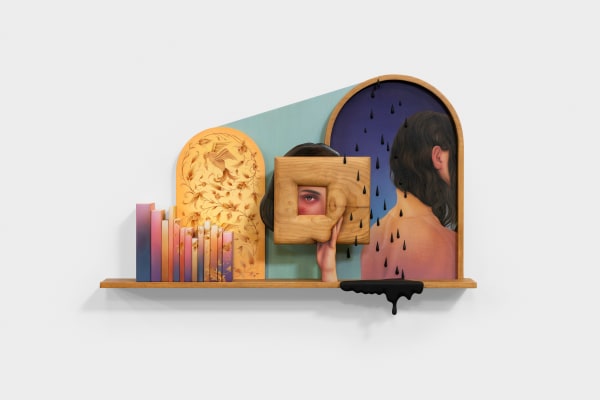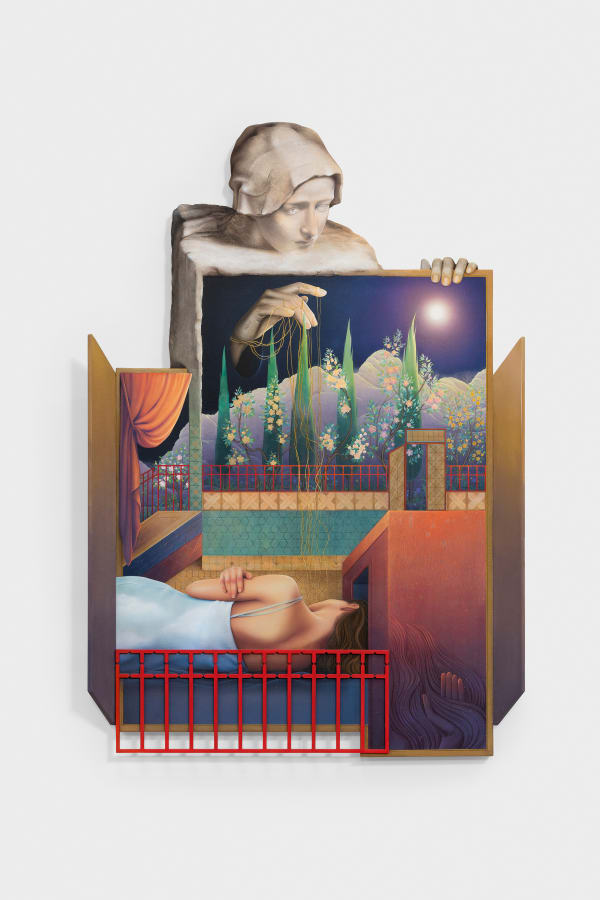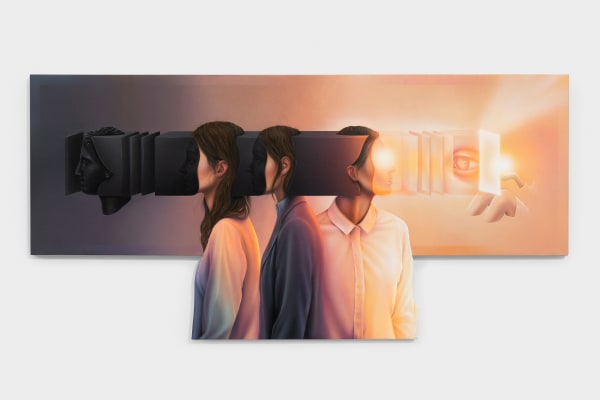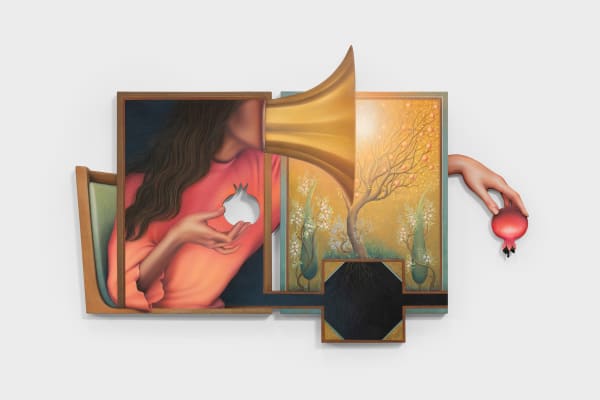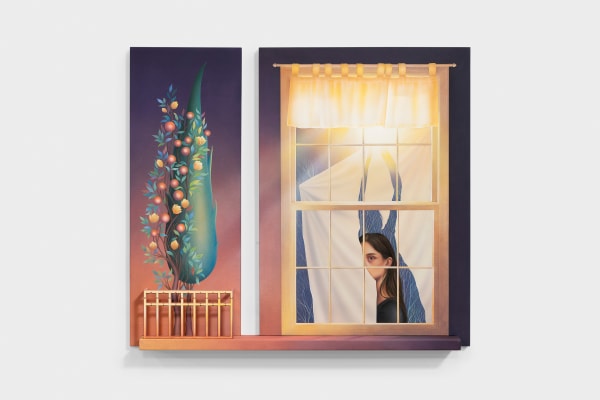"BETWEEN LIGHT AND SHADOW" ARGHAVAN KHOSRAVI: Paris
Every painting, every sculptural intervention, carries within it a dialogue between opposing forces: color palettes that contrast sharply, transparent and solid surfaces placed in tension, traditional Persian motifs juxtaposed with contemporary techniques. This aesthetic of contradiction is not a stylistic choice alone; it mirrors the lived experience of negotiating between inner freedom and external control, personal belief and imposed ideology. It is rooted in the embodied experience of living between two cultural and ideological systems. Raised in post-revolutionary Iran, she internalized the sharp division between public life—governed by surveillance, conformity, and religious codes—and private life, where individual agency, desire, and dissent could be quietly expressed. This split is not merely social but deeply psychological, and Khosravi gives it visual form: rooms within rooms, doors that open onto nothing, veiled figures who nevertheless radiate defiance. Her paintings reveal the emotional labor of performing compliance while inwardly resisting, of being simultaneously visible and invisible.
This tension extends beyond the Iranian context, touching on broader questions of identity, gender, and exile. Khosravi’s use of traditional Persian motifs—floral arabesques, ornamental architecture, miniature-style compositions—is not nostalgic but strategic. These references to heritage are recontextualized through a contemporary lens, often juxtaposed with surreal distortions or symbolic interventions. In doing so, she unsettles the past, refusing to let it rest in aestheticized familiarity.
Even the construction of her works reflects this internal duality. She often builds her paintings from layers of shaped wood panels and mixed media, blurring the line between painting and sculpture. The viewer is invited not only to look at but to look through—into spaces that suggest both revelation and concealment, intimacy and distance.
A hallmark of Khosravi's practice is in fact her unique blend of Persian miniature painting traditions with Western surrealism and contemporary elements. She reclaims and reinterprets the architectural forms, floral motifs, and flat ornamental perspectives characteristic of Persian miniatures; however, she subverts these traditional narratives through her use of Western color palettes, painterly depth, and multidimensionality, giving her subjects agency and visual power. She subverts these traditional narratives by giving agency and prominence to female figures, who are typically passive or secondary in historical miniatures.
Khosravi’s compositions are often structured with stacked perspectives and cutaway views, creating a spatial ambiguity that feels at once dreamlike and deliberately fractured. Her works are not confined to the flatness of the canvas: they are not merely two-dimensional surfaces, they are emphatically sculptural and multi-dimensional, constructed from layers of shaped and painted wood panels, stretched canvas, and architectural forms adding depth and optical illusions. This structural complexity is integral to her storytelling, allowing for a constantly shifting perceptual experience.
Furthermore, her mixed-media approach deepens this narrative potential. Traditional Iranian textiles, threads, Plexiglas, leather cords, and found objects such as feathers are integrated into her paintings, blurring the boundaries between image and object, memory and materiality. These tactile elements open interpretive space, inviting viewers to generate their own readings and emotional connections.
Khosravi traces the philosophical roots of the internal duality of her work to Zoroastrianism, the ancient pre-Islamic religion of Iran, whose worldview is structured around opposing forces.
Koshravi individuated a philosophical lineage underlying the internal duality of her work with ancient Zoroastrianism, the pre-Islamic religion of Iran, with its binary cosmology of good and evil, light and dark. In this framework, duality is not something to be resolved but endured and understood.
In contrast to the Christian trinity, Zoroastrian belief is structured around opposing forces: good and evil, light and darkness, order and chaos. Though no longer practiced widely, its metaphysical imprint lingers, and for Khosravi, it offers a symbolic lineage that helps explain her enduring interest in opposition as a structural principle of thought and expression.
By invoking this ancient metaphysical lineage, Khosravi opens a new dimension in the reading of her work. The dualities she stages are not only responses to contemporary political tensions and their actual perception—they are also echoes of a much older philosophical tradition. Her paintings thus operate on multiple temporal and symbolic planes: they are both present and ancient, personal and mythic. In this sense, Khosravi’s paintings doesn’t simply depict duality; it inhabits it, inviting the viewer to witness the fragile space where contradictions are not resolved, but held—visibly, vulnerably—in tension.
They unfold like poems—symbolic, layered, and open-ended. They resist linear narration in favour of suggestion, metaphor, and emotional resonance. Just as a poem invites the reader to linger, interpret, and inhabit ambiguity, her images ask the viewer to slow down and engage not only with what is depicted, but with what is implied, hidden, or withheld. In this space, interpretation is not fixed but fluid, shaped by the viewer’s own memory, feeling, and imagination.
- Written by Claudia Cargnel
-
 Arghavan Khosravi, The Shelf (A Domestic Scene), 2025
Arghavan Khosravi, The Shelf (A Domestic Scene), 2025 -
 Arghavan Khosravi, Hypnose, 2025
Arghavan Khosravi, Hypnose, 2025 -
 Arghavan Khosravi, Threshold, 2025
Arghavan Khosravi, Threshold, 2025 -
 Arghavan Khosravi, Broken Pieces, 2025
Arghavan Khosravi, Broken Pieces, 2025 -
 Arghavan Khosravi, Passages, 2025
Arghavan Khosravi, Passages, 2025 -
 Arghavan Khosravi, The Absence, 2025
Arghavan Khosravi, The Absence, 2025 -
 Arghavan Khosravi, Signal, 2025
Arghavan Khosravi, Signal, 2025 -
 Arghavan Khosravi, Eclipse, 2025
Arghavan Khosravi, Eclipse, 2025 -
 Arghavan Khosravi, Gleam, 2025
Arghavan Khosravi, Gleam, 2025 -
 Arghavan Khosravi, Morrow, 2025
Arghavan Khosravi, Morrow, 2025 -
 Arghavan Khosravi, The Totem (four Cypresses), 2025
Arghavan Khosravi, The Totem (four Cypresses), 2025

